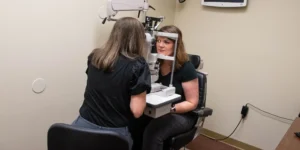Each year, organizations like the American Optometric Association (AOA) and Prevent Blindness designate March as National Save Your Vision Month to promote eye health. This year, the AOA advocates for people to take a “day of unplugging” to raise awareness about digital eye strain and the impact of blue light emissions from digital screens on overall health.
According to the AOA’s Eye-Q survey data, 88% of Americans know that digital devices can negatively affect their vision, but the average American still spends at least 7 hours per day using devices like smartphones, tablets, computers, and flat-screen TV’s. Other estimates put the amount of time Americans spend on digital devices at 10 or 12 hours.
Overexposure to blue light, the high-energy visible light emitted from digital devices, can contribute to:
- Dry eyes
- Watery eyes
- Fatigued or strained eyes
- Blurry vision
- Frequent headaches
- Neck and shoulder pain
- Loss of concentration
- Difficulty sleeping
How To Avoid Digital Eye Strain
The AOA understands that digital devices are an important part of everyday life, and that using them is unavoidable for many jobs and professions. The following tips can help you protect your eyes and monitor digital screen usage while at home or work:
- Follow the 20-20-20 rule: When you are using any digital device or computer, make a conscious effort every day to look away from the screen every 20 minutes at something 20 feet away for 20-seconds.
- Keep a comfortable arm’s length working distance from your digital device by using the zoom feature to see small print and details rather than bringing the device closer to your eyes.
- Reduce glare by adjusting device settings or using a glare filter to decrease the amount of blue light reflected from the screen.
- Unplug for a day, or at least a morning, afternoon, or evening.
- Power down before you turn in. Turn your digital devices off at least one hour before bed.
- Talk with your eye doctor about whether special lenses would help.
Special Lenses
Since computer monitors are typically 20 to 26 inches from your eyes, your regular glasses may not be the best option for computer work. This distance range is considered intermediate, which is closer than what you use to drive a car but farther away than what you use to read. Special lens designs for computer work provide you with a larger intermediate area for viewing the computer and your immediate work area like the top of your desk. Hardin Valley Eyecare & Optical can help you determine if these special lenses are appropriate for you.
For AOA’s infographic about the hazards of digital eye strain, click here.
If you are experiencing any of the symptoms listed above due to prolonged exposure to digital screens, schedule an appointment with Hardin Valley Eyecare & Optical in Knoxville. Our eye care professionals are dedicated to providing exceptional personal service to each person who walks through our door. Call us at (865) 246-1500 or contact us to schedule an appointment.





